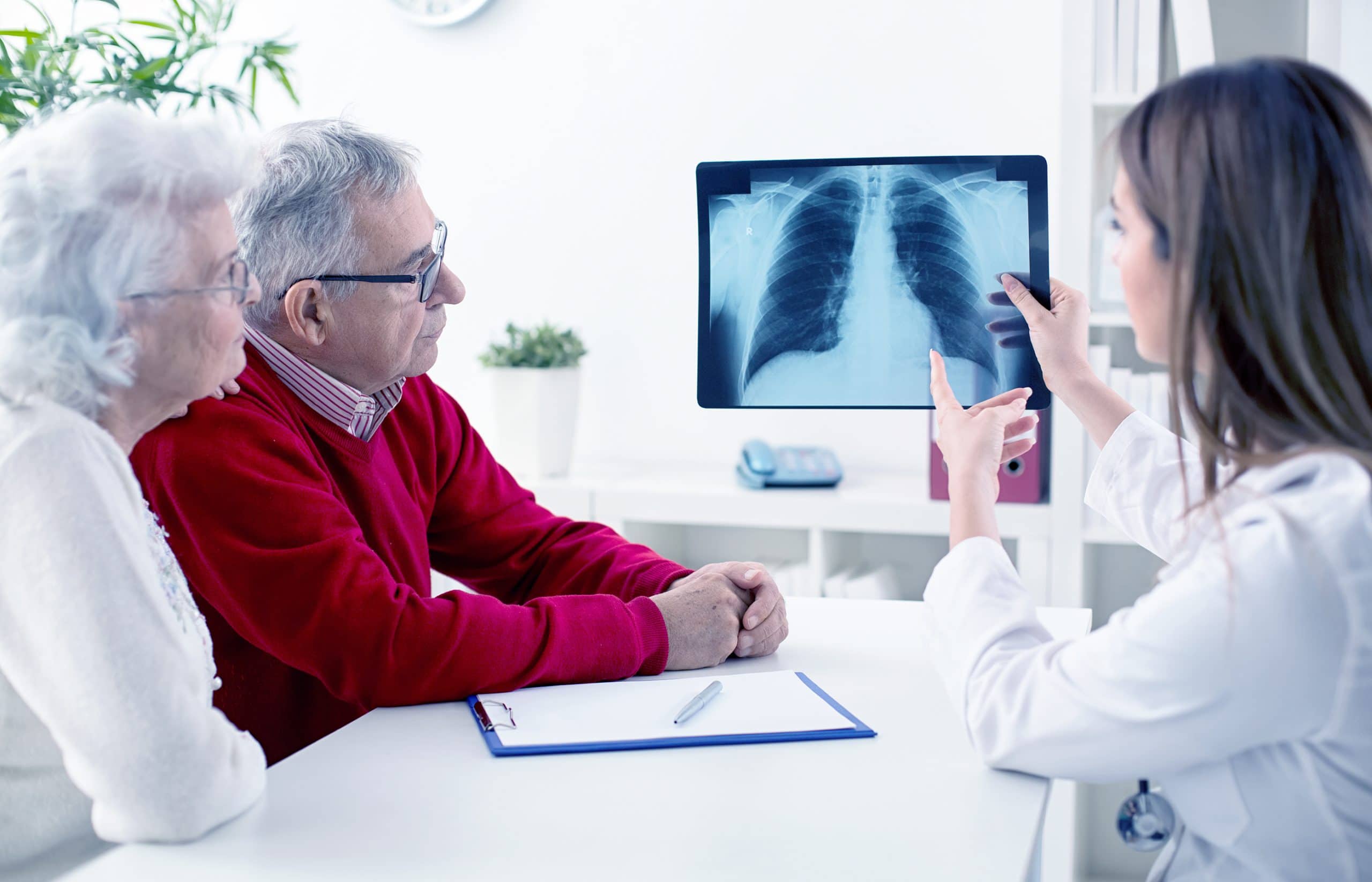Smoking and Risk of Lung Cancer
Lung Cancer is the leading cause of cancer-related death in the United States. Though the number of deadly lung cancer cases has decreased in the last two decades, over 150,000 Americans die from the disease each year. Only breast cancer accounts for more cancer cases among people living in the United States. Smoking is the leading cause of lung cancer.

Smoking and Lung Cancer Risks
Lung Cancer is a type of cancer that begins in the lungs. The two major forms of lung cancer are non-small cell lung cancer and small cell lung cancer. Tumors can develop in the lungs as a result of smoking, environmental hazards like asbestos and radon, secondhand smoke, and other risk factors.
Symptoms of lung cancer include chronic coughing (with blood), chest pain, weight loss, and wheezing. Most symptoms appear in the advanced stages of lung cancer, but patients can experience other unexpected symptoms earlier on. Treatment options vary between surgery, chemotherapy, radiation therapy, targeted drug therapy, and immunotherapy.
How Does Smoking Cause Lung Cancer?
Cells are the structure of all things living. Trillions of cells make up the structure of the human body by taking in nutrients and converting them into energy. Cells in the lungs and throughout the body contain specific growth and death patterns to keep organs functioning.
Harmful substances like tobacco smoke and environmental gases cause damage to healthy lung cells. When lung cancer begins to develop, the natural cycle of the cells mutates until cell division becomes irregular and produces too many cells. The rapid division of cells prevents them from functioning like normal lung cells and creates tumors.
Lung Cancer Risk Factors Other Than Smoke
Risk factors increase a person’s chance of getting a disease. The risk factors can be voluntary, such as smoking, or involuntary, like age or genetics. Different cancers have different risk factors. Risk factors for some diseases are still unknown.
Having a risk factor does not necessarily guarantee you will develop a disease or cancer. Some risk factors, however, significantly increase the chance of developing lung cancer. The most common risk factor for lung cancer is smoking, but other factors can influence the risk.
Tobacco smoking
About 80%-90% of lung cancer cases involve current or former smokers. As the most significant risk factor for lung cancer, the harmful substance in smoke causes significant damage to the body. The longer someone smokes, the greater the risk of lung cancer. Cigarettes, cigars, and tobacco pipes are risk factors for lung cancer, even if the tobacco is “low-tar” or “light.”
Radon
The naturally-forming radioactive gas called radon increases the risk of lung cancer. The gas, which we cannot see, smell, or taste, forms naturally in the soil and rocks below our homes. Radon is the second leading risk factor for lung cancer.
Asbestos
For centuries, people have been coming into contact with asbestos at work, at home, or throughout the natural environment. People with specific jobs, such as shipyard workers, construction workers, and first responders, have the highest risk for asbestos exposure. Asbestos causes other diseases, too, including mesothelioma and asbestosis. Other naturally occurring carcinogens include arsenic, chromium, nickel, soot, and tar.
Air pollution
We come into contact with outdoor air pollution as soon as we step outside. Even if we stay inside, we still risk indoor air pollution. Outdoor air pollutants include diesel fumes, dust, soot, sulfur dioxide, and many others. Indoor air pollutants include kerosene fuels, coal, and biomass (organic matter).
Family or Personal History of Lung Cancer
Unfortunately, the risk of developing lung cancer can increase based on family relations. The risk of lung cancer increases when someone has an immediate family member, like parents, siblings, or children, with lung cancer. Researchers believe the association between family and risk of lung cancer may be due to environmental similarities such as smoking. There are rare cases of inherited lung cell mutation among family members.
Age
Age is a risk factor for lung cancer and other forms of cancer. About two-thirds of all lung cancer cases involve patients 65 years or older.
Smoking Can Accelerate Other Health Conditions
Smoking can significantly accelerate the onset of lung cancer and other health conditions. Smokers who have an asbestos-related disease like mesothelioma can experience worsened symptoms and a reduction in their body’s ability to fight cancer.
Asbestosis is a chronic lung condition caused by prolonged exposure to asbestos. Smokers who were exposed to asbestos have an elevated risk of developing asbestosis. If someone starts smoking before being exposed to asbestos, their lungs are more susceptible to more fibers becoming attached, eventually causing the onset of asbestosis.
Other diseases involving the lungs, including emphysema or pulmonary fibrosis, can cause scarring in the lung tissues. Scar tissue is known to cause cell mutation that can lead to lung cancer. Smoking combined with a history of lung disease increases the risk of lung cancer even more.
Best Ways To Quit Smoking
With over 40 million active smokers in the United States, addiction to nicotine sustained through smoking is a problem that is tough to solve. However, quitting smoking can improve your physical and mental health. It is difficult to quit smoking with or without the help of various methods.
Nicotine Replacement Therapy (NRT)
There are several kinds of NRTs designed to decrease the craving for nicotine. Most are available over the counter, but some may require a prescription. NRTs can also reduce the symptoms associated with nicotine addiction.
A nicotine patch is an FDA-approved method that releases a certain amount of nicotine into the bloodstream. The larger the patch, the more the nicotine is released. The purpose of wearing a patch is to reduce nicotine over time with a controlled delivery.
Chewing gums used to quit smoking contain nicotine that is released to the bloodstream quicker than a patch. The controlled amount of nicotine eases people out of the addiction within three months.
Lozenge is a hard candy that contains nicotine and has the same purpose as gum and the patch. One dose can last up to 30 minutes while the nicotine enters the bloodstream. Smokers should not consume Lozenge more than 20 times a day.
Inhaled Medications
Inhaled medications such as nasal sprays or an inhaler deliver nicotine quickly to the bloodstream. Nasal spray is the quickest way for nicotine to reach the bloodstream, as the lining of the nose absorbs it almost instantly. An inhaler delivers nicotine to the bloodstream via the mouth. Nicotine from inhalers enters the body more slowly than nicotine from cigarettes but contains less harmful components.
Oral Medications
Medications like Bupropion (Zyban) help to reduce the craving to smoke cigarettes. However, it does not release nicotine like NRT methods. Doctors prescribe Bupropion to adults who smoke ten or more cigarettes a day. The drug should not be used in conjunction with alcohol, monoamine oxidase inhibitors (MAOI), or other medicines that contain Bupropion.
Varenicline (Chantix) is a smoking cessation therapy medication that affects nicotine’s influence on our smoking behaviors by reducing craving and withdrawal. This medication also blocks the satisfying feeling of nicotine.


